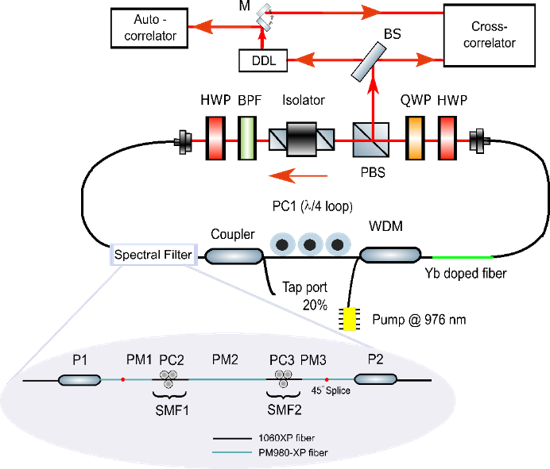Mode-locked lasers are the building blocks to generate ultrafast pulses which can then be used for many applications, including optical communication, metrology, spectroscopy, microscopy, material processing, as well as many applications in the healthcare industry. Mode-locked fiber lasers are especially popular for their compactness, efficiency, and beam quality compared to their solid-state counterparts. Apart from their practicality, the mode-locked fiber lasers are an interesting object for studies, as they represent dynamically rich nonlinear systems.
So far, the pulse formation in mode-locked fiber lasers is modeled very well by a popular equation called the Cubic Quintic Ginzburg Landau equation (CQGLE). The solution of this equation is described as dissipative solitons as the pulse formation is due to dissipative processes and elements in the laser system such as gain, saturable absorber, and spectral filter.
The spectral filtering term used in the equation has a single maximum response (2nd order) which represents a smooth gain spectrum. In reality, a laser gain medium may have multiple peak structure which CQGLE modeling fails to accommodate. To solve this problem, researchers use another equation – the complex Swift Hohenberg equation (CSHE). This equation has a double-peak spectral filtering term (4th order) which resembles a multipeak gain structure. The solution of this equation is also dissipative solitons.
In the past twenty years, many research groups have performed numerical studies of CSHE and have shown that pulses with complicated symmetric and asymmetric profiles can be generated and, in some cases, pulses have exceptionally high energy. Unfortunately, there was no strong experimental evidence of a CSHE fiber laser.
The ultrafast laser research group led by Dr. Andy Chong at the University of Dayton has successfully designed the first CSHE-based dissipative soliton fiber laser, which is based on a birefringent fiber-based bandwidth tunable spectral filter. Such filter can generate a variety of transmission profiles including the double-peak spectral response required for the CSHE realization. The research results are published in Photonics Research, Volume 9, Issue 6, 2021 (Ankita Khanolkar, Yimin Zang, Andy Chong. Complex Swift Hohenberg equation dissipative soliton fiber laser[J]. Photonics Research, 2021, 9(6): 06001033).
In this research work, numerical simulations are carried out to understand the pulse formation mechanism for a CSHE fiber laser. Interestingly, a moving soliton solution was found. An important conclusion is established through these numerical simulations i.e. the greater the asymmetry of the spectrum, the higher the velocity of moving pulses irrespective of the sign of the velocity.
Experimental realization of this laser is accomplished using ytterbium (Yb) as a gain medium at 1030 nm. The most important component in the experimental laser configuration shown in Fig. 1, is the spectral filter.
This spectral filter consists of alternate sections of polarization maintaining (PM) and single mode fibers (SMF) which produces sinusoidal multipeak transmission. As the required spectral filter response for the CSHE is a double peak, a bandpass filter is used to facilitate the selection of double peak spectra from the multipeak transmission. The rest of the cavity design is very similar to the standard all-normal dispersion mode-locked fiber lasers.
Along with the highly asymmetric output spectrum, this laser produces output pulses with a complicated asymmetric profile. The most exciting part of this work is detecting moving solitons and verifying the conclusion derived from numerical simulations with experimental observations. The difference in the velocities of moving dissipative solitons is measured in terms of the change of repetition rate of the laser. The pulse energy and duration are ~3 nJ and ∼100 fs, respectively. The pulse energy can be easily improved by implementing the same laser design using double clad fibers.
Authors of paper, Ankita Khanolkar and Yimin Zang say—"By building a CSHE fiber laser, we have facilitated the observation of almost two decades old numerical phenomenon. Our laser cavity can serve as a powerful testbed to study rich dynamics of dissipative solitons of CSHE."
The team is attempting to experimentally achieve a high pulse energy solution of CSHE originally numerically obtained in previous year. The research group is hopeful that they can build a high pulse energy CSHE dissipative soliton laser at normal as well as anomalous dispersion. This would be a breakthrough innovation, particularly for mode-locked fiber lasers at anomalous dispersion as the pulse energies for these lasers are limited.
The team is also doing further research on the effects of more complicated spectral filtering in mode-locked fiber lasers. Indeed, these results have opened a new course in future ultrafast fiber laser research.

Fig. 1. Schematic of the fiber oscillator along with the measurement system.
(PBS, polarizing beam splitter; HWP, half waveplate; QWP, quarter waveplate; BPF, bandpass filter; PC, polarization controller; WDM, wavelength division multiplexer; P, in-line polarizer; PM, polarization-maintaining; SMF, single mode fiber; BS: beam splitter; M: mirror; DDL: dispersion delay line)


